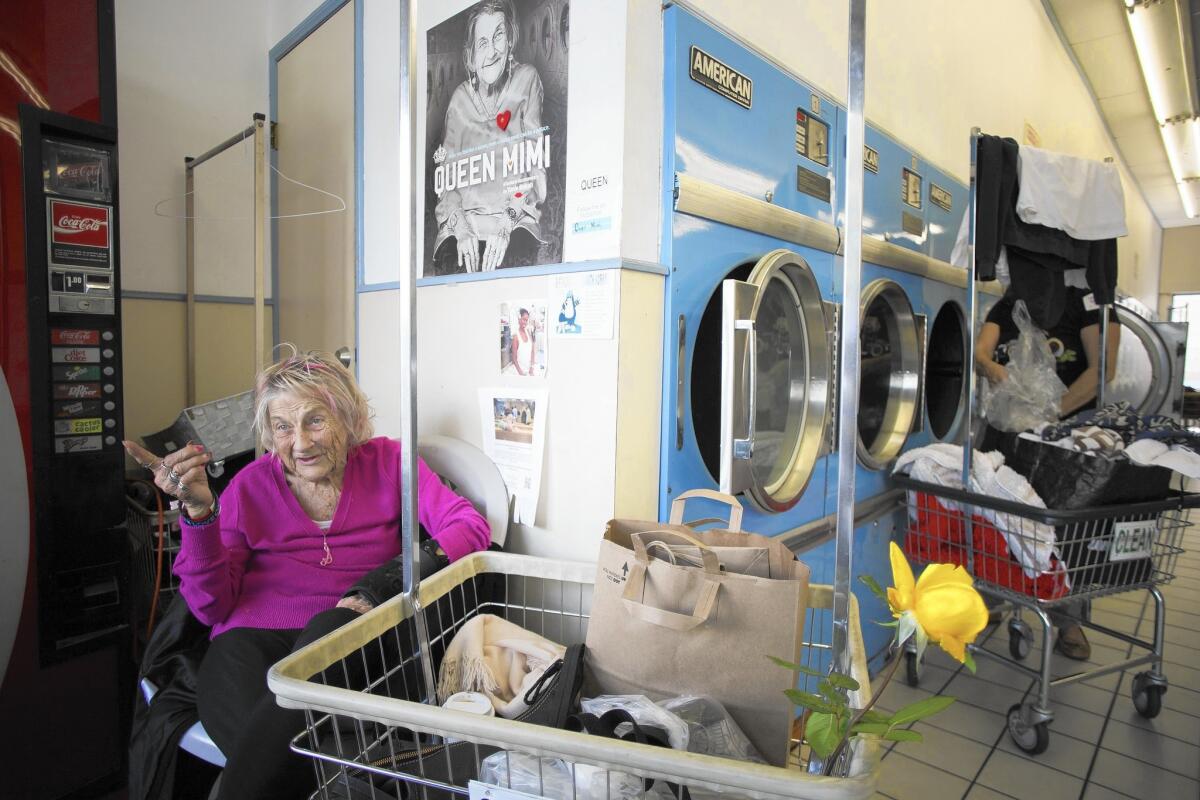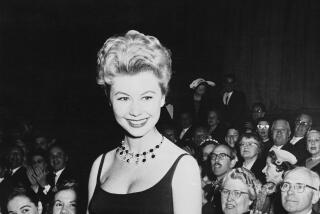‘Queen Mimi’ is at home on the red carpet -- and in a strip-mall laundromat

- Share via
Just to be clear, Mimi was famous long before anyone made a movie about her.
People called her the Queen of Montana Avenue — but not because she was rich.
Now this 90-year-old who for nearly two decades slept in a strip-mall laundromat spends her days fielding interview requests from the likes of People magazine.
She holds court as she has for years, just inside Fox Laundry’s front door, in a plastic chair next to the soda machine. On the wall above her is a poster with her picture on it, advertising the documentary “Queen Mimi.”
“The sun’s out. The sky’s blue. It was supposed to rain today, but it didn’t. That’s life on planet Earth,” she says, chatting on her cellphone. She wears tight black leggings, white flip-flops, a pink cashmere sweater. She has pink polish on her nails, pink streaks in her dyed blond hair.
Mimi was never a laundromat employee, although for years she folded clothes for tips. She still guards the place and barks, “Don’t slam it!” when someone manhandles a dryer.
One of my favorite sayings is, yesterday’s gone, tomorrow’s not here yet, live in the now. I made up my mind a long time ago to be happy.
— Queen Mimi
Look at the Yelp page for Fox Laundry, and comments about her abound from those who’ve encountered Mimi’s brusqueness without context. But she’s made many a friend at the laundry too.
It’s where she became close to actor Zach Galifianakis, in the late 1990s, before he made it big. He has brought Mimi with him to parties. She’s been his red-carpet date. “We talk about sex, Mimi and I, and we laugh a lot,” he says at one point in “Queen Mimi.” At another: “It is my honor to know that woman.”
That’s just one of the surprises in the film, which opens Friday in Santa Monica. Another is the way Mimi is treated in one of the tonier parts of town.
By her side in the laundry is the metal laundry cart — complete with garment-hanging rack — that she wheels around her neighborhood, accepting its beneficence daily. She gets hugs, free food and drink, and deep discounts at chic restaurants. If there are lines, she is whisked to the front of them.
The cart holds her purse and people’s offerings: a large yellow rose, pastry, kiwi fruit. It also serves as a walker. Mimi’s back is severely bowed, maybe from the years in which her bedroom was the aisle between the single- and double-load washers, her bed a plastic lawn chair with a matching one placed in front of it for her legs.
She took a spill at the grocery store recently. Her left hand’s in a wrist brace. She wriggles the fingers of her right hand, which sparkle with rings she’s found.
A young man walks in, nicely built, five o’clock shadow, dragging a bulging garbage bag. “I’d like to crawl all over him,” Mimi says, not so sotto voce, her deep blue eyes so twinkly and her grin so mischievous that she looks like a kid, even though she’s lost her teeth and wrinkles groove every inch of her face.
“Queen Mimi” was more than five years in the making, funded through an online Kickstarter campaign.
Yaniv Rokah, an aspiring actor from Israel, was new to Los Angeles when he got a job as a barista at Cafe Luxxe, just across Montana Avenue from the laundromat.
He came in with the cafe’s rags, which the Fox staff washed in exchange for free drinks. He brought Mimi coffee, and she started coming to visit.
Outside Cafe Luxxe, there’d often be a line of big-name industry types, he said. “Nicole Kidman, Paul Haggis, they’d wait for half an hour — and here comes this shiny lady in bright pink, so full of life... It really was exciting to see someone so different.”
Rokah had no filmmaking experience and no plan in mind when he started videotaping interviews with Mimi on his iPhone 4. “I wasn’t actually making a film,” he said. “I just knew that there was a story there that I wanted to capture.”
The more he teased that story out of her, the more he felt compelled to share it — although getting Mimi to examine her life can be difficult. Before the movie, she had done a good job of shedding her past, even those she has loved.
“One of my favorite sayings is, yesterday’s gone, tomorrow’s not here yet, live in the now,” she says. “I made up my mind a long time ago to be happy.”
Mimi’s full name is Marie Elizabeth Haist. She was born in downtown Los Angeles in 1925. She married in 1947. For 29 years, she was a suburban housewife — china cabinets in the dining room, sheets drying on the line in her Woodland Hills backyard.
That life, in her telling, began to unravel when her husband was unfaithful. In 1976, they divorced. She promptly lost the house. In her 50s, she began living in her van. When she couldn’t pay her vehicle license fee, the van was towed away — everything she’d held on to from her old life inside it.
She made her way to the Westside, where she lived on the street, lining plastic bags with newspaper to make shoes, eating food thrown out by restaurants. She slept behind bushes in front of what was then Bullock’s Westwood, in doorways just off Pacific Coast Highway and on Montana.
One day she noticed the laundry and started hanging out there. One bitterly cold, rainy night, the janitor called the owner and asked if he could let her sleep inside. That one night turned into many. Stan Fox let Mimi have her own set of keys.
Friends she met on Montana took her in for stretches, offering beds and couches. They took her out to meals, at which she ordered her favorite lemon drop martinis.
Mimi never asked anyone for money, she says, even when she slept on sidewalks. “If you asked a man, he might expect something out of you, so I just never did.”
She also somehow never thought of herself as homeless. She’s known to demand that homeless people who wander into the laundromat leave.
Sometimes she still shuts her eyes at the laundromat, stretched out on a bench in front of the plate-glass window.
But Mimi doesn’t spend the night there anymore. She has her own bed, in her own apartment right across Montana.
Rokah says getting that part of the story on film took some doing. Galifianakis rents the apartment for her. Renee Zellweger, who met Mimi through him, furnished the three small rooms. Neither wanted public attention for it.
In “Queen Mimi,” Galifianakis talks about first getting Mimi a cellphone so that she could more easily keep in touch. One thing led to another.
“You see people that are down on their luck or on the streets and stuff, and rarely do we as a society try to reach out on a personal basis,” he says. “It just seemed like the right thing to do for a friend. And I should have probably done it sooner, to be honest with you.”
As for Mimi, having a home hasn’t made her a homebody. She likes to take her place at the laundromat each day, soon after it opens.
Twitter: @latimescitybeat
ALSO
These 2 teens with similar backgrounds took very different paths to college
When childhood innocence and gang violence lived side by side in Boyle Heights
How tech mogul Larry Ellison’s friendship with a USC doctor led to $200-million cancer research gift
More to Read
Sign up for Essential California
The most important California stories and recommendations in your inbox every morning.
You may occasionally receive promotional content from the Los Angeles Times.











